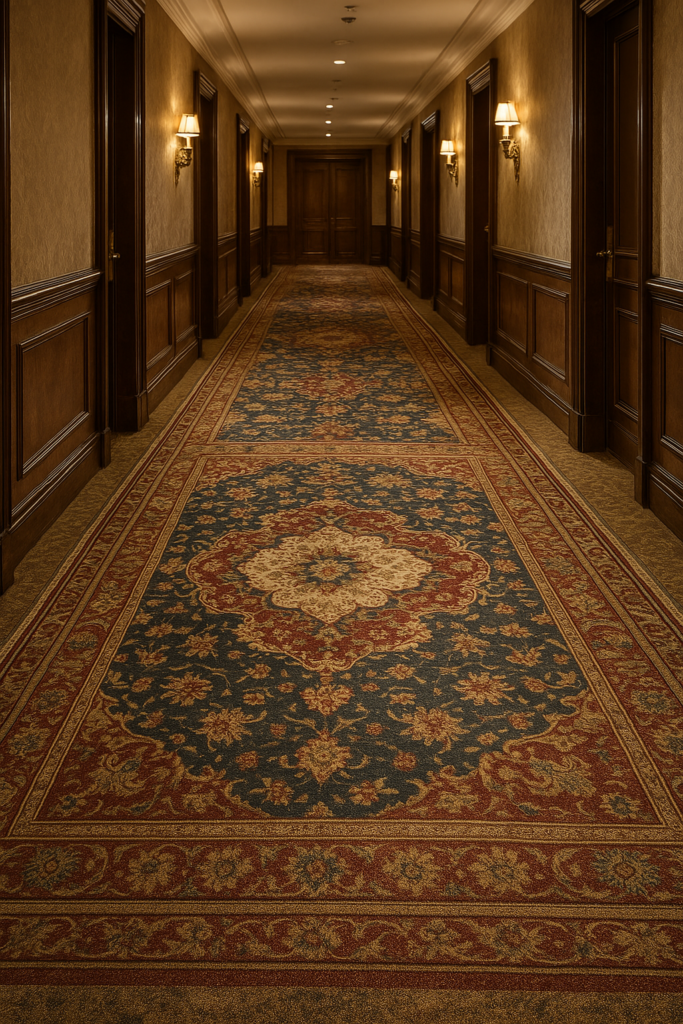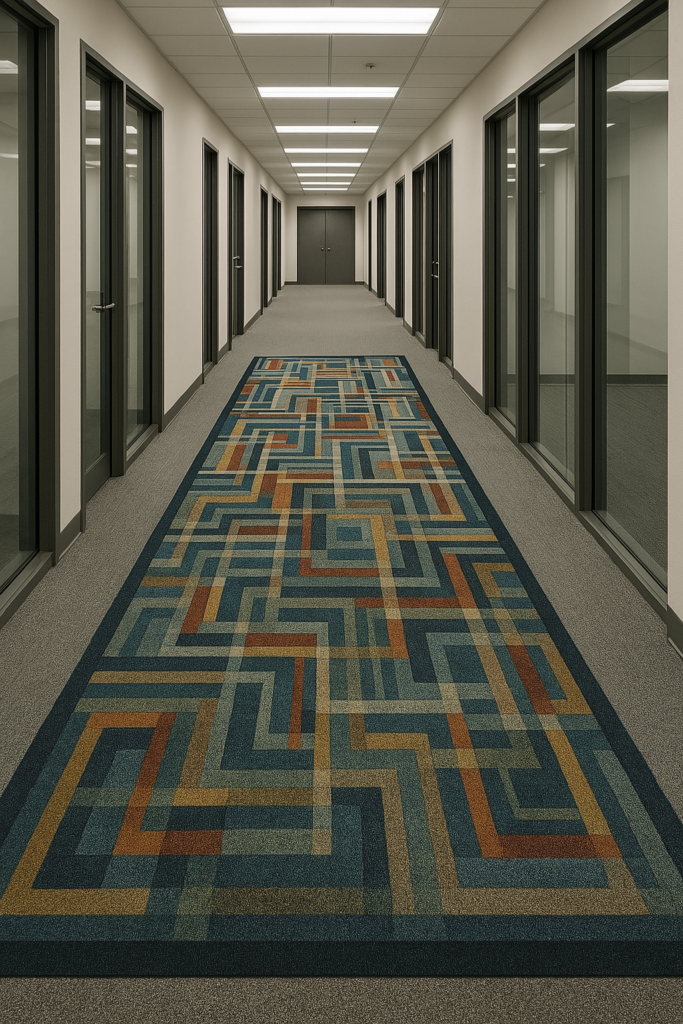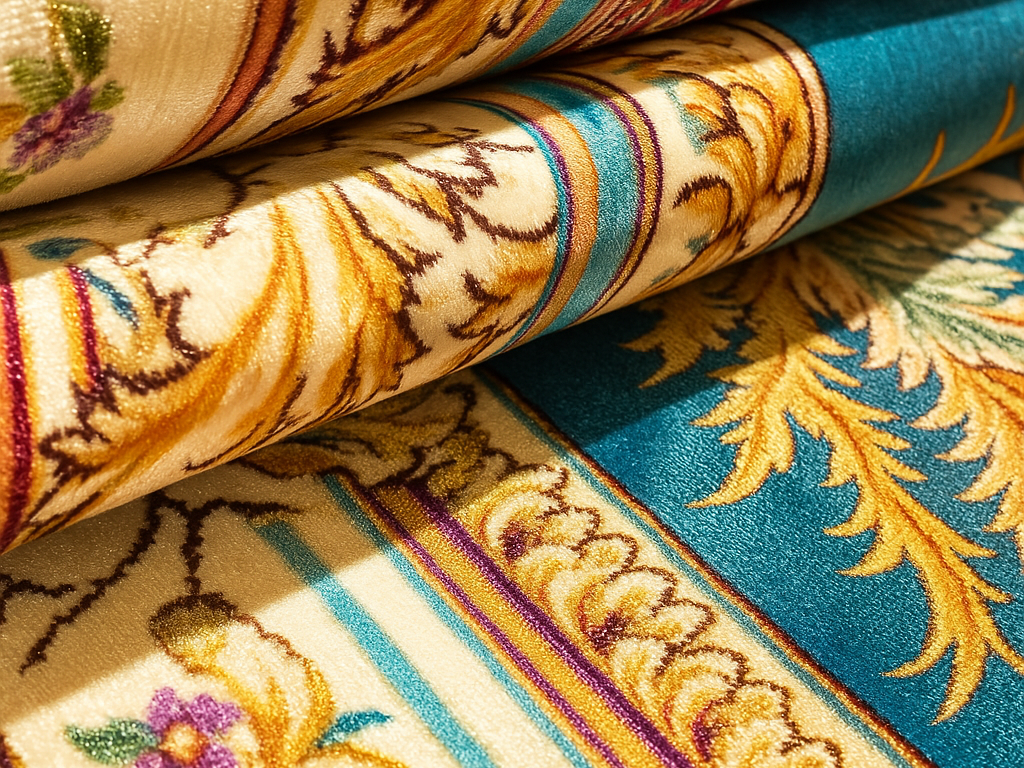복도 러너 러그는 바닥을 보호하면서 공간의 흐름을 개선하는 기능적, 미적 목적을 모두 충족합니다. 올바른 크기와 스타일을 선택하는 것은 어려울 수 있지만 표준 치수, 적절한 측정 기술 및 신중한 배치를 이해하면 프로세스를 단순화할 수 있습니다. 이 가이드는 복도에 딱 맞는 러너 러그를 선택하는 데 도움이 되는 전문가의 인사이트를 제공합니다.

1. 표준 러너 러그 사이즈는 무엇인가요?
복도 러너 러그는 일반적으로 다양한 복도 폭과 길이에 맞게 특정 치수로 제공됩니다. 이러한 표준 크기를 이해하면 공간에 적합한 러그를 선택하는 데 도움이 될 수 있습니다.
표준 너비
- 24 인치 (2피트): 매우 좁은 복도나 최소한의 바닥 면적이 필요한 공간에 이상적입니다.
- 27 인치 (2.25피트): 대부분의 복도에 적합한 커버리지와 공간 사이의 균형을 제공하는 일반적인 너비입니다.
- 30 인치 (2.5피트): 더 넓은 커버리지를 제공하여 넓은 복도 또는 더 큰 존재감을 원할 때 이상적입니다.
- 36 인치 (3피트): 넓은 복도에 적합하며 충분한 커버리지와 대담한 표현을 제공합니다.
표준 길이
- 6 피트: 짧은 복도나 장식용 액센트로 적합합니다.
- 7피트: 대부분의 표준 복도에 맞는 다용도 길이입니다.
- 8피트: 중간 길이의 복도에 이상적이며 균형 잡힌 모양을 제공합니다.
- 10피트: 긴 복도에 적합하며 러그가 바닥의 상당 부분을 덮을 수 있습니다.
- 12피트 이상: 매우 긴 복도에 사용되어 연속적인 커버리지를 보장합니다.
고유한 복도 치수에 맞게 사용자 지정 크기도 사용할 수 있다는 점에 유의하세요.
관련 읽기: 다양한 방 스타일에 딱 맞는 터프티드 러그 선택하기
2. 복도 러너는 얼마나 길어야 하나요?
복도 러너의 적절한 길이를 결정하려면 복도의 크기와 원하는 미관을 고려해야 합니다.
- 길이 측정: 줄자를 사용하여 복도의 정확한 길이를 결정하세요.
- 양쪽 끝에 바닥 공간 남기기: 전문가들은 균형 잡힌 외관을 위해 러너의 양쪽 끝에 6~12인치의 노출된 바닥을 남겨둘 것을 권장합니다.
- 벽에서 벽까지 커버리지 피하기: 러너를 벽과 같은 높이에 놓으면 공간이 비좁아지고 공기가 제대로 흐르지 않을 수 있습니다.
이 가이드라인에 따라 복도의 비율을 보완하는 러너 길이를 선택할 수 있습니다.
관련 읽기: 적합한 러그 크기를 선택하는 방법: 방별 가이드
3. 복도 러너 러그를 측정하는 방법
복도 러너 러그를 완벽하게 맞추고 기능성과 미관을 모두 향상시키려면 정확한 치수가 중요합니다. 다음은 복도를 측정하고 적절한 러그 사이즈를 선택하는 데 도움이 되는 단계별 가이드입니다.

1단계: 복도 너비 측정하기
가장 좁은 지점에서 복도의 폭을 측정하는 것부터 시작하세요. 표준 복도 너비는 일반적으로 36~48인치입니다. 균형 잡힌 모양을 위해 러그의 양쪽에 약 4~6인치의 노출된 바닥을 남겨두는 것이 좋습니다. 즉, 복도의 폭이 36인치인 경우 24인치 너비의 러너는 양쪽에 약 6인치의 바닥을 남겨두어 비례를 맞추는 것이 좋습니다.
예시:
- 복도 너비: 36인치
- 권장 러그 너비: 24인치
- 양쪽 바닥이 노출되어 있습니다: (36 - 24) / 2 = 6인치
2단계: 복도 길이 측정하기
다음으로 복도의 한쪽 끝에서 다른 쪽 끝까지의 길이를 측정합니다. 균형 잡힌 모양을 위해 러너가 복도 길이의 약 4분의 3을 덮고 양쪽 끝에 6~12인치의 노출된 바닥을 남겨두는 것을 목표로 하세요. 이렇게 하면 러그가 너무 짧아 보이거나 공간을 압도하는 것을 방지할 수 있습니다.
예시:
- 복도 길이: 12피트
- 권장 러그 길이: (12피트 × 0.75) = 9피트
- 양쪽 끝이 노출된 바닥: (12피트 - 9피트) / 2 = 1.5피트
3단계: 러그 배치 시각화하기
러그의 치수가 복도에 적합한지 확인하려면 러그 배치를 시각화하는 것이 도움이 됩니다. 마스킹 테이프를 사용하여 바닥에 러그의 발자국 윤곽을 그려보세요. 이 기법을 사용하면 러그가 공간에 잘 맞는지 확인하고 필요한 경우 구매하기 전에 조정할 수 있습니다.
4단계: 문 간격 고려하기
러너 러그가 문을 막거나 움직임을 방해하지 않는지 확인하세요. 러너 러그가 문을 여닫을 때 문제를 일으키지 않는지 확인하기 위해 문 바닥과 바닥 사이의 간격을 측정하세요.
5단계: 불규칙성 설명
복도에 곡선, 골방 또는 기타 불규칙한 특징이 있는 경우 측정할 때 이를 고려하세요. 곡선형 복도의 경우 모양에 맞게 러그의 치수를 조정해야 할 수 있으며, 맞춤형 러너를 선택해야 할 수도 있습니다.
관련 읽기: 러그의 계단 및 계단을 측정하는 8가지 전문가 단계
4. 복도 러너 러그를 선택하는 방법
올바른 복도 러너 러그 선택하기 공간의 미적 감각과 기능성을 보완할 수 있도록 다양한 요소를 고려해야 합니다. 다음은 정보에 입각한 선택을 돕기 위한 확장된 가이드입니다:
복도의 치수 이해
러너를 선택하기 전에 복도의 폭과 길이를 정확하게 측정하세요. 이렇게 하면 러너가 적절하게 맞고 양쪽 바닥이 균형 있게 노출되도록 할 수 있습니다. 일반적으로 러너가 복도 길이의 약 75%를 덮고 양쪽 끝에서 6~12인치의 바닥이 노출되도록 하는 것이 좋습니다.
적절한 자료 선택
러너 러그의 소재는 내구성과 편안함 모두에 영향을 미칩니다. 다음 옵션을 고려하세요:
- Wool: 내구성이 뛰어나고 자연적으로 얼룩이 잘 지워지지 않습니다, 울 는 트래픽이 많은 지역에 이상적입니다.
- 면: 부드럽고 세척하기 쉬운 면 러너는 교통량이 적은 구역에 적합합니다.
- 합성 섬유 (예 나일론, 폴리에스테르): 저렴하고 얼룩과 변색에 강해 바쁜 복도에서 실용적으로 사용할 수 있습니다.
- 황마 또는 사이 잘삼: 친환경적이고 질감이 있는 이 소재는 자연스러운 아름다움을 더하지만 관리가 더 필요할 수 있습니다.
복도의 용도 및 유지보수 선호도에 맞는 소재를 선택하세요.
파일 높이 고려
그리고 파일 높이 는 러그의 섬유 두께를 나타냅니다. 복도 러너의 경우 파일 높이가 낮거나 중간 정도인 것이 좋습니다:
- 낮은 더미: 청소가 쉽고 걸림이 적어 교통량이 많은 지역에 적합합니다.
- Medium 파일: 편안함과 내구성 사이의 균형을 제공합니다.
복도에 깔개를 높이 쌓아두면 문 이동에 방해가 되고 관리가 더 어려워지므로 피하세요.
적합한 패턴과 색상 선택
러너의 패턴과 색상은 복도 장식과 잘 어울려야 합니다:
- 뉴트럴 톤: 베이지, 회색 또는 회갈색은 차분한 분위기를 연출하고 다양한 인테리어 스타일에 어울립니다.
- 대담한 패턴: 줄무늬, 기하학적 디자인 또는 꽃 모티브는 개성을 더하고 포인트로 사용할 수 있습니다.
- 어두운 색상: 먼지와 얼룩을 효과적으로 가려주어 교통량이 많은 공간에 이상적입니다.
- 밝은 색상: 공간을 밝게 하고 좁은 복도를 더 넓게 보이게 합니다.
러그의 디자인이 전체적인 미적 감각과 조화를 이루고 복도의 분위기를 향상시키는지 확인하세요.
안전 기능 우선 순위 지정
특히 교통량이 많은 지역에서는 안전이 가장 중요합니다:
- 미끄럼 방지 뒷면: 러그가 미끄러지는 것을 방지하여 걸려 넘어질 위험을 줄여줍니다.
- 러그 패드: 추가적인 접지력을 제공하고 러그와 바닥을 모두 보호합니다.
이러한 기능에 투자하면 러너가 안전하게 제자리를 유지할 수 있습니다.
내구성 및 유지 관리 평가
복도에는 유동 인구가 많은 경우가 많으므로 내구성이 매우 중요합니다:
- 얼룩 방지: 합성 섬유나 처리된 양모와 같이 얼룩에 강한 소재를 선택하세요.
- 간편한 청소: 세탁기로 세탁할 수 있거나 쉽게 얼룩 제거할 수 있는 러그를 선택하세요.
- 페이드 저항: 특히 햇빛에 노출된 경우 러그의 색상이 시간이 지나도 선명하게 유지되는지 확인하세요.
진공 청소기로 청소하고 얼룩을 즉시 제거하는 등 정기적으로 관리하면 러그의 수명을 연장할 수 있습니다.
집의 스타일에 맞는 러너 맞추기
러너는 집의 전체적인 디자인을 반영해야 합니다:
- 전통 주택: 복잡한 패턴의 페르시아 또는 오리엔탈 러그는 우아함을 더할 수 있습니다.
- 모던한 인테리어: 무채색과 깔끔한 라인의 미니멀리스트 디자인이 현대적인 공간을 보완합니다.
- 다양한 스타일: 패턴과 색상을 믹스 앤 매치하여 독특하고 개성 있는 룩을 연출하세요.
러너의 스타일을 집안 장식에 맞추면 응집력 있고 매력적인 분위기를 연출할 수 있습니다.
5. 복도 러너 러그 배치 방법
러너 러그를 적절히 배치하면 복도의 외관과 기능을 향상시킬 수 있습니다.
배치 팁
- 러그 중앙 배치: 복도 중앙에 러그를 정렬하여 균형 잡힌 모양을 만듭니다.
- 가구와 정렬: 복도에 가구가 있는 경우 러그가 가구의 배치와 일치하는지 확인하세요.
- 보행자 트래픽 허용: 러그가 통로를 막거나 걸려 넘어질 위험이 없는지 확인하세요.
이 배치 팁을 따르면 러너 러그가 복도의 레이아웃과 디자인을 보완할 수 있습니다.
6. 복도 러너 러그 관리 방법
복도 러너 러그의 외관, 기능 및 수명을 유지하려면 관리가 필수적입니다. 정기적인 관리는 공간의 미적 매력을 향상시킬 뿐만 아니라 미끄러짐과 낙상을 방지하여 안전을 보장합니다. 다음은 복도 러너 러그를 효과적으로 관리하는 데 도움이 되는 심층 가이드입니다.
정기적인 진공 청소기 사용
정기적인 진공청소기는 먼지와 이물질에 대한 첫 번째 방어선입니다. 복도는 유동인구가 많기 때문에 러그를 청결하게 유지하는 것이 중요합니다. 적어도 일주일에 한 번씩 진공청소기로 청소하면 먼지가 섬유에 박히는 것을 방지하는 데 도움이 됩니다. 프린지가 있는 러그의 경우 엉킴을 방지하기 위해 덮개가 부착된 진공청소기를 사용하세요.
스팟 클리닝 유출 및 얼룩
사고가 발생하면 얼룩이 굳는 것을 방지하기 위해 신속한 조치가 필요합니다. 다음은 일반적인 유출 사고에 대처하는 방법입니다:
- 액체: 깨끗한 흰색 천으로 즉시 해당 부위를 닦아 액체를 최대한 많이 흡수하세요. 문지르면 얼룩이 섬유에 더 깊숙이 스며들 수 있으므로 문지르지 마세요.
- 음식 및 기름: 순한 주방 세제와 따뜻한 물을 섞어 얼룩진 부위에 발라주세요. 부드러운 천으로 바깥쪽에서 안쪽으로 부드럽게 닦아냅니다. 깨끗한 물로 헹구고 물기를 닦아내세요.
- 애완동물 얼룩: 백 식초와 물을 섞은 용액을 사용해 냄새를 중화하세요. 해당 부위를 닦은 다음 깨끗한 물로 헹구고 물기를 닦아내세요.
세정액을 얼룩에 바르기 전에 항상 러그의 작고 눈에 띄지 않는 부분에 테스트해 보세요.
딥 클리닝
러너는 정기적으로 진공청소기로 청소하고 스팟 청소를 하더라도 시간이 지나면 더 철저한 청소가 필요할 수 있습니다. 러그의 소재와 관리 지침에 따라 다릅니다:
- 세탁기로 세탁 가능한 러그: 제조업체에서 허용하는 경우 찬물과 중성 세제를 사용하여 세탁기로 부드럽게 세탁하세요. 다시 놓기 전에 완전히 자연 건조하세요.
- 손으로 빨 수 있는 러그: 욕조나 큰 대야에 시원한 물과 소량의 울 전용 세제를 채우세요. 러그를 담그고 부드럽게 저어주세요. 비누가 모두 제거될 때까지 찬물로 깨끗이 헹굽니다. 짜내지 말고 여분의 물기를 짜낸 다음 평평하게 눕혀서 말리세요.
- 전문 청소: 섬세하거나 골동품 러그의 경우 손상을 방지하기 위해 전문 청소 서비스를 고려하세요.
곰팡이 건조 및 예방
청소 후에는 러그를 적절히 건조시켜 곰팡이 및 곰팡이 번식을 방지하는 것이 중요합니다:
- 공기 건조: 변색을 방지하기 위해 직사광선을 피해 통풍이 잘되는 곳에 깔개를 평평하게 놓아주세요.
- 습기 방지: 러그를 복도에 다시 놓기 전에 완전히 건조되었는지 확인하세요. 축축한 러그는 불쾌한 냄새와 곰팡이 번식의 원인이 될 수 있습니다.
회전 및 패딩
러그의 수명을 연장하고 고른 마모를 보장합니다:
- 정기적으로 회전: 몇 달에 한 번씩 러그를 180도 회전하세요. 이렇게 하면 발자국을 고르게 분산시키고 마모 패턴이 고르지 않게 방지할 수 있습니다.
- 러그 패드 사용: 미끄러짐을 방지하고 조기 마모를 유발할 수 있는 마찰을 줄이기 위해 아래에 미끄럼 방지 러그 패드를 깔아주세요. 패드가 러그보다 약간 작아야 가장자리에서 패드가 튀어나오지 않습니다.
손상으로부터 보호
러그의 무결성을 유지하기 위해:
- 직사광선 피하기: 햇빛에 장시간 노출되면 섬유가 변색되고 약해질 수 있습니다. 커튼이나 블라인드를 사용하여 직사광선으로부터 러그를 보호하세요.
- 무거운 가구 자국 방지: 러그 위에 무거운 가구를 직접 올려놓으면 섬유에 홈이 생기고 스트레스를 받을 수 있으므로 피하세요.
- 느슨한 실 다듬기: 실이 느슨한 부분이 있으면 가위로 조심스럽게 다듬으세요. 러그가 풀릴 수 있으므로 잡아당기지 마세요.
시즌별 유지 관리
계절이 바뀌면 러그에 영향을 미치는 조건도 달라집니다:
- 봄과 여름: 습도가 높아지면 곰팡이 번식이 촉진될 수 있습니다. 적절한 환기가 이루어지도록 하고 필요한 경우 전문 청소를 고려하세요.
- 가을과 겨울: 신발의 염분과 습기는 러그에 얼룩을 남길 수 있습니다. 엎질러진 물은 즉시 닦아내고 이 계절에는 메인 러그를 보호하기 위해 세탁 가능한 러너를 사용하는 것이 좋습니다.
7. 결론
올바른 복도 러너 러그를 선택하려면 표준 크기를 이해하고, 공간을 정확하게 측정하고, 적절한 소재와 디자인을 선택하고, 러그를 올바르게 배치하고 유지 관리해야 합니다. 이 가이드에 제공된 가이드라인을 따르면 잘 선택한 러너 러그로 복도의 기능성과 미적 매력을 향상시킬 수 있습니다.
8. 자주 묻는 질문
Q1: 러너 러그가 내 복도에 적합한지 어떻게 알 수 있나요?
복도의 폭과 길이를 측정하여 러그의 양쪽에 4~6인치의 노출된 바닥을 남겨두세요.
Q2: 짧은 복도에 러너 러그를 사용해도 되나요?
예, 복도 대부분을 덮을 수 있는 러그 길이를 선택하고 양쪽 끝에서 6~12인치의 바닥이 노출되도록 합니다.
Q3: 복도 러너 러그에는 어떤 소재가 가장 적합하나요?
울, 합성 섬유, 면과 같은 내구성이 뛰어난 소재는 교통량이 많은 지역에 적합합니다.
Q4: 러너 러그가 미끄러지는 것을 방지하려면 어떻게 해야 하나요?
미끄러지지 않는 뒷면이 있는 러그를 사용하거나 아래에 러그 패드를 깔아 미끄러지지 않도록 하세요.
Q5: 복도 러너 러그는 얼마나 자주 청소해야 하나요?
정기적으로 진공 청소기로 청소하고 유출물은 즉시 처리하세요. 정밀 청소를 위해 주기적으로 전문 청소를 고려하세요.


